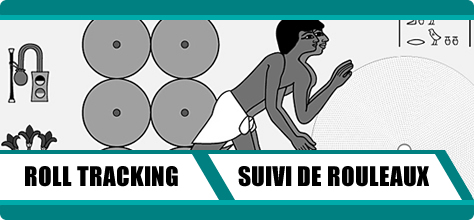
HISTORY OF ROLL TRACKING
What is roll tracking, anyway?
"Roll tracking" is the process of following paper products through a paper mill and warehouse. Without accurate roll tracking, mills would grossly over- or under-run their orders, causing significant waste of production capacity and a reduction in the quality of customer service. Minimizing waste is crucial for a mill to remain competitive in today's market.
Computerize it!
The mid 1970s saw the birth of computerized product tracking. A company called MDDC automated the process using General Automation mini-computers. As with many early computers, these large and expensive early systems performed their task using 16 kilobytes of core memory and 5 megabyte disk packs! Seemingly underpowered when compared to today's average desktop PC that typically has over 512 megabytes of RAM and 80 gigabytes of hard drive space.
Since the birth of computerized product tracking, technology has moved in two directions. Some systems were upsized to either super-mini or mainframe computers, while others were downsized to microcomputers. This is a process we now call rightsizing. Roll tracking systems are a paper industry term for what other industries commonly call a "Manufacturing Execution System" (MES). Previous terms have included Computer Integrated Manufacturing (CIM) or Computer Assisted Manufacturing (CAM).
Evolution
Before computerization, mills often identified paper rolls by assigning sequential numbers. Each roll was weighed and its weight and roll number were recorded manually. This information was then stenciled or rubber-stamped onto a label that was then glued to the roll. The only way to track the roll's parentage or quality information was to physically look up this information in manually created and maintained production logs. The effort required clearly indicated a need for automation. Automation began in the 70s when some paper mills started using a large, mechanical printing system called a Magna Printer. Placed directly on the wrapline, these behemoths used stepper motors to turn massive rubber stamps that stamped the information on large labels for gluing onto the rolls.
Making it better
Improving automation saw the replacement of these largely mechanical printers with more modern dot-matrix printers. These new printers produced labels that were more attractive and had better readability, while dramatically reducing maintenance costs. Today there is a vast choice of printers including dot matrix, laser, and thermal transfer printers that can produce attractive multilingual labels with barcoded data and computer-generated graphics.
To minimize data entry, the systems kept track of customer and order information. This freed operators from always having to re-enter this information for every roll processed. With order data already in the computer, it did not take long to develop ways to use all this stored information to efficiently schedule the paper machines and provide production and inventory management. With the development of accurate inventory management, the systems soon extended to shipping. In addition to accurate production reports, the systems started collecting product quality information from various process information systems from Distributed Control Systems (DCS) and quality laboratories. Communicating the customer's finishing requirements to the wrapline's Programmable Logic Controller (PLC) completed the automation process.
Wrapmation is committed to further develop and modernize these systems.
Modern roll tracking systems are infinitely more powerful than their product-tracking ancestors. Paper mills improve their efficiency and reduce their costs by using modern systems that run on network-based PC workstations. The last five years have seen the growth of Enterprise Resource Planning (ERP) systems. Paper mills were no exception, and Wrapmation was ready to integrate mill floor production with ERP packages, providing accurate and up-to-date production information that is shared with other enterprise-critical data.
The benefits
Roll Tracking Systems have provided:
-
Better scheduling, productivity, and yield improvements, allowing for assured customer delivery promises
-
Improved capacity management and reduced waste
-
Improved quality control and tracking to the roll and pallet level
-
More efficient logistics with fewer errors
-
An ability to manage almost all customer expectations
- Empowered mill personnel to make informed decisions, based on real time data